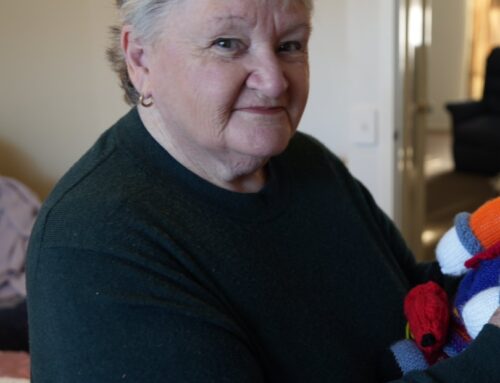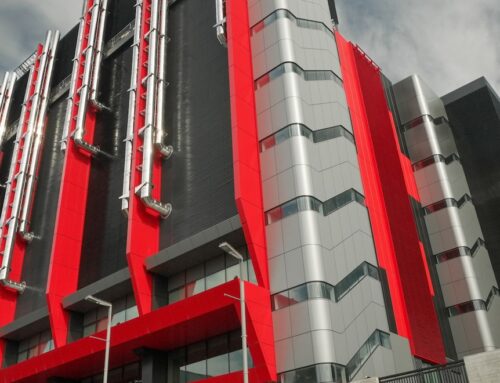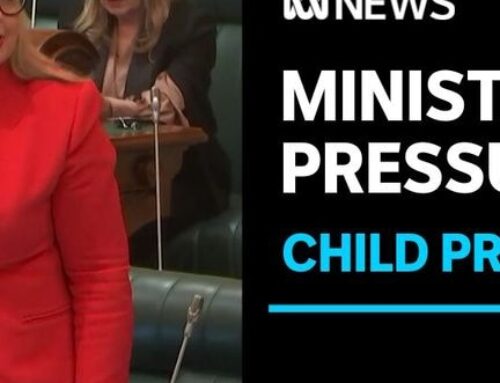Driving her trusty red Camry, wearing a T-shirt emblazoned with “Australian Nuclear Free Alliance”, Aunty Sue Haseldine is on a cross-country mission.
“We’ve travelled a long way and a lot of miles,” she tells 7.30 somewhere between her home at Ceduna in South Australia and Port Kembla in New South Wales.
Her latest target is AUKUS, specifically the part of the security pact between Australia, the US and UK that will as one pillar see Australia acquire a fleet of nuclear-powered submarines that could one day rotate through “the beautiful waters” of Port Kembla.
For Aunty Sue, this is deeply personal.
“I was about two years old when the atomic tests started at Maralinga … I was on a mission called Koonibba,” she recalls.
“I don’t remember much of the tests, of course, but my oldies told me things about the Nullarbor dust storm.
“The kids all thought it was a dust storm coming in and the oldies are yelling at them to get in the house because they knew it was poison.”
She later developed thyroid cancer and from then on, she decided to “fight anything nuclear”.
In the 1950s and 60s, Britain conducted a dozen nuclear tests at Maralinga in South Australia and the Montebello Islands off Western Australia, scarring a landscape and a people, while helping to sow the seeds of a deep anti-nuclear movement.
Palm Sunday rallies drew hundreds of thousands of Australians protesting the proliferation of nuclear weapons, and later, France’s controversial nuclear testing program in the Pacific — a campaign fuelled further by the sinking of Greenpeace’s Rainbow Warrior boat by French agents in Auckland.
The Cold War also cast a long shadow.
It would influence a generation of trade union and Labor leaders and ultimately, state and federal policies too.
To this day, Australia — a major uranium exporter — has just one nuclear research reactor at Lucas Heights in Sydney that produces life-saving medicines for cancer detection and treatment.
All other installations — including nuclear power — are banned.
Ban on nuclear ‘stunted’ the debate
Sydney-based lawyer Helen Cook has just finished drafting a national nuclear law for the Philippines government, one of several in the region considering nuclear to cut emissions and increase energy security.
She spent over a decade working overseas, including the United States — home to more than 90 nuclear reactors — and says colleagues would often hear her Aussie accent and immediately ask why Australia had banned nuclear energy.
“I found it a very difficult question to answer other than simply to use my own experience, which was to say that when I left Australia, I didn’t know anything about nuclear energy,” she says, emphasising: “Literally nothing.”
Now recognised as an international expert, Ms Cook says she’s found most Australians she talks to are curious about nuclear and she hasn’t received the negative reaction she expected.
2024, it seems, is a different time to just two decades ago.
The year was 1998 and prime minister John Howard needed the support of the Greens and Democrats in the Senate to pass new laws upgrading the Lucas Heights reactor.
They would only agree if he added an amendment prohibiting “certain nuclear installations” including a nuclear power plant.
The same ban was later added to federal environmental laws and Queensland, Victoria and New South Wales doubled down, forbidding nuclear power in their states too.
When asked what impact these bans had on the nuclear debate in Australia, nuclear engineer and Australian Nuclear Association president Mark Ho has a simple answer. It’s stunted the conversation.
“A lot of countries are using nuclear to decarbonise. The question is whether we should lift the ban,” Dr Ho says.
“I think we should. It’s [been] a long time coming.”
Thirty-two countries currently operate around 440 nuclear reactors, supplying 10 per cent of the world’s energy.
‘Plan B’?
The Coalition, now led by Peter Dutton, wants Australia to be among them.
He’s preparing to take an energy policy to the next election that includes a promise to lift the ban and explore the use of both large-scale and small modular reactors, or SMRs, possibly on the site of retiring coal-fired power stations.
Mr Dutton believes the world has changed since Australia last really considered the question of nuclear power under Mr Howard.
Australia has committed to achieving net zero emissions by 2050, coal is exiting the grid, power prices are rising and there’s a growing backlash in parts of regional Australia to the massive expansion of wind, solar and transmission projects.
Nuclear power plants, conversely, have a small footprint and perform a similar “firming” or “baseload” role to coal and gas, without the emissions.
But few have been built since the 1990s and the ones that have, have typically been beset by delays and huge cost blowouts. And that’s what the political debate has boiled down to: cost and time.
Labor — long opposed to nuclear — isn’t considering any use of a technology it believes is eye-wateringly expensive and too poisonous to sell to the electorate. It’s banking on a grid dominated by renewables to meet Australia’s future energy needs and mandated climate targets.
Tony Wood is the Grattan Institute’s energy director and agrees that right now, the economics for nuclear power “are terrible”.
But in the midst of a challenging, once-in-a-century energy transition, Mr Wood is also technology agnostic and reckons Australia would be wise to consider a plan B, just in case.
“Personally, I think Australia should have a grown-up discussion around the role of nuclear and I don’t think the ban helps that,” he says.
“There are some significant unknowns about nuclear, but the promise of small modular reactors [SMRs] is quite attractive to Australia because if you could dramatically drive down the cost, then that could be interesting in the future and so we should watch that.”
According to Dr Ho, SMRs are an attractive prospect because they’re smaller, safer, cheaper to build and easier to deploy than large-scale reactors.
“Their targeted time frames are about 3 to 5 years for construction compared to say 5 to 8 years for large nuclear,” he says.
Several designs are in development, with the most advanced aiming to be completed around 2030.
In its GenCost report, the CSIRO estimated the capital costs of an SMR would top $31,000 per kilowatt, compared with $3,040/kW for wind and $1,525/kW for large-scale solar.
However, those figures are contested.
A peer-reviewed 2020 study by the University of Queensland estimated the cost would be between $4,700/kW and $9,900/kW. The report says the capital costs would be recovered over the lifetime of the project.
On the question of timing, Ms Cook cites the International Atomic Energy Agency’s own figures, which suggest a country can go from considering nuclear energy to having nuclear energy in its grid within 10 to 15 years.
“And that is starting from scratch,” she adds.
“Australia is not starting from scratch. Australia has existing nuclear infrastructure that we would build up if we decided to go down a nuclear path.”
Are attitudes changing?
The biggest obstacle to change, as Tony Wood sees it, is that nuclear by definition “sounds scary”.
But as Ms Cook points out, the three countries where the worst nuclear disasters have taken place — the United States, Japan, and Ukraine — are not just doubling down but “trebling down on their nuclear generation commitments”.
“The United States, Japan and Ukraine are signatories to the pledge that was made at COP28 to triple our global nuclear energy capacity by 2050,” she says.
“To me, that is significant.”
There are signs too that attitudes might be shifting — albeit for different reasons.
While the labour movement is broadly anti-nuclear, the Australian Workers’ Union has always been open to nuclear energy for the jobs and energy-intensive industries it could support.
The Victorian branch of the Mining and Energy Union also became pro-nuclear following the shock closure of the Hazelwood coal-fired power station in 2017, leaving nearly 1,000 workers without jobs.
Essential polling suggests about half of Australians back the development of nuclear power and a recent Newspoll found 55 per cent of respondents supported the use of small modular reactors on the site of retiring coal-fired power stations.
Support was highest among younger Australians.
“Young people are very open to it,” says associate professor Edward Obbard, the head of nuclear engineering at UNSW.
“They don’t have the same kind of social upbringing that the Boomer and Gen X’s did of living through the Cold War and nuclear disarmament and that whole tumultuous period.
“Nowadays people think the greatest threat to their future is climate change and they’re willing to consider all good solutions to that.”
Dr Obbard is training the next generation of engineers who will be in greater demand thanks to AUKUS — a pact that will force Australia to build up a nuclear workforce and settle on a location to store the waste, regardless of whether it pursues nuclear power.
He was “amazed” by the “deafening silence” when the submarine plans were announced and believes it has, unquestionably, changed the scene for nuclear more broadly.
“For me, the case to use nuclear energy is actually a moral case because it is an environmentally low-impact way to decarbonise,” Dr Obbard says.
For Aunty Sue Haseldine, nuclear power would leave quite a different legacy.
“We must think about the next generation and what are we going to leave them. Are we going to leave them nice clean fresh air? Or nuclear mines and waste dumps?” she asks.
In her opinion, there’s no place for nuclear anywhere. Her mission is far from over.
Watch 7.30, Mondays to Thursdays 7:30pm on ABC iview and ABC TV




